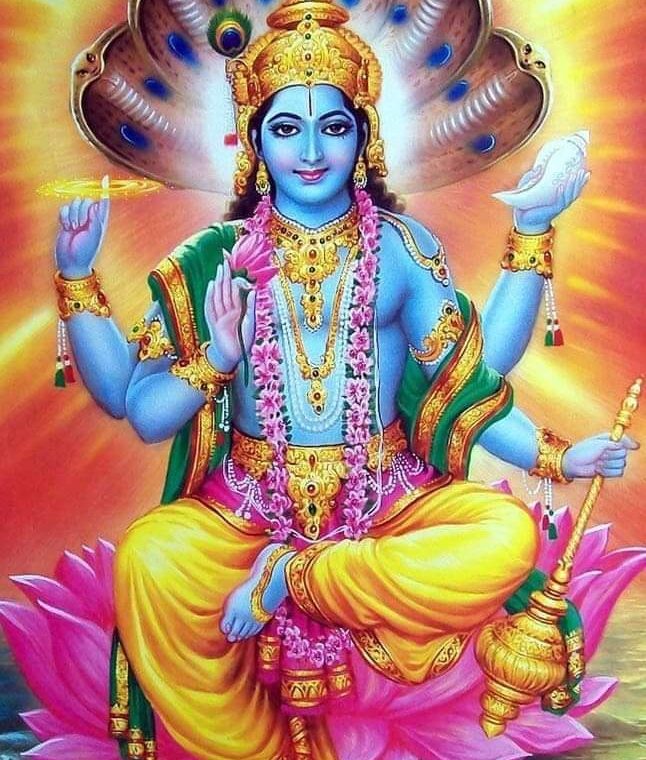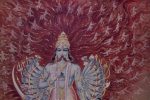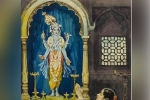NAME 68
Śreṣṭhaḥ श्रेष्ठः
Śreṣṭha refers to the highest degree of splendour. Chāndogya Upniṣad quoted above used this word to describe prāṇa and through prāṇa, the Brahman.
These nāma-s do not simply say that Brahman is the Supreme, but also say why it is Supreme. This Nama means that He is the greatest or the most glorious one.
Sri Adi Sankara says ‘Prashasyatamah Shreshttah – greater than the greatest’. He also elucidates further by calling Him the power behind all powers and the Cause of all Causes.
Shreshttah is the superlative of Shreyah (glorious). It is to be noted that the sequence of the three Namas above, Praana, Jyeshtta and Shreshttah is the same sequence that occurs in the Chandogya Upanishad – Praano vaava Jyeshttascha Shreshttascha.
The Story of Bhrigu
Many great sages gathered at the bank of river Saraswati to participate in the Maha Yagna organised at that time. Maharishi Bhrigu was also present there. All the great Saints and Sages could not decide that out of the Trinity Lord Vishnu, Brahma and Shiva who is pre-eminent and to whom should they offer Pradhanta (Master) of that Yagna. With the consent of all the great Saints present there, it was decided that Maharishi Bhrigu will conduct a test and decide who was pre-eminent amongst the Trinity.
Upon being entrusted with the task Maharishi Bhrigu decided to test Lord Brahma first. He went on to see Lord Brahma in Brahmaloka. On reaching Brahmaloka Maharishi intentionally displayed utter disrespect to Lord Brahma. Lord Brahma got angry and wanted to punish the Maharishi but Saraswati, wife of Lord Brahma saved the Maharishi from his anger. Maharishi Bhrigu cursed Lord Brahma that no one will worship Brahma in Kaliyug out of his anger. To this day, there are very few temples devoted to Lord Brahma (the notable exception being the Temple at Pushkar).
Maharishi Bhrigu then decided to visit Lord Shiva at Mount Kailash. However, upon reaching Mount Kailash, Nandi stopped him from entering the abode as at that time, Shiva and Parvati were sporting fun.
Bhrigu felt slighted and cursed Lord Shiva to be only worshipped in Linga form. (We however have a statue form of Lord Shiva in Kashi (Maha Mrityunjaya Temple) said to be 400+ years ago.
Then in order to test Lord Vishnu, Maharishi reached Vaikunta. He entered Vaikunta without Lord Vishnu’s permission and saw that the Lord was resting at that time. Maharishi asked him to wake up, but Lord was in deep sleep. On seeing no reaction from Lord, Maharishi kicked Lord Vishnu on his chest (that strike by Maharishi Bhrigu left a foot print on Lord’s chest and that footprint is known as “Shri Vatsa”).
Lord Vishnu got up after the strike and realised what had happened. On realizing that Maharishi had kicked him with his foot, Lord asked him, “Maharishi, are you hurt in your foot? My chest is strong but your foot is not so strong”.
Vishnu apologised, seated the Maharshi on a throne and pressed the feet and removed the extra eye of the Sage in one of his soles (Sage Bhrigu was proud of that eye).
Immediately the spiritual eye of Bhrigu opened and he realised his mistake and also praised Vishnu for His ‘Satvik’ qualities and declared to the assembly of the sages that Vishnu is greatest or ‘Shreshttah’.
Shreshttah – One who is Glorious
६८. ॐ श्रेष्ठाय नमः |
68. OM Śreṣṭhāya Namaḥ
Sreshthah -The most Glorious One: Here again it is the superlative degree of glorious, Sreyah
Praśasyatamaḥ (प्रशस्यतमः) One deserving the highest praise. Sarvān ati śete (सर्वान् अति शेते) As He is the highest Being excelling others, He is Śreṣṭhaḥ.
Chāṃdogyopaniṣat 5.1 :: छांदोग्योपनिषत् – पंचम प्रपाठकः, प्रथम खंडः
Oṃ. Yohavai jyeṣṭhaṃca śreṣṭhaṃca veda jyeṣṭhaśca havai śreṣṭhaśca bhavati prāṇo vāva jyeṣṭhaśca śreṣṭhaśca. (1)
ॐ. योहवै ज्येष्ठंच श्रेष्ठंच वेद ज्येष्ठश्च हवै श्रेष्ठश्च भवति प्राणो वाव ज्येष्ठश्च श्रेष्ठश्च ॥ १ ॥
The one who has firmly realized that the element of Mukhya Prāṇa or the Vital Force as being the first cause and thus elder to all, becomes the same.
INTERPRETATION GUIDED BY SANT VANI (WORDS OF SAINTS)
Śreṣṭhaḥ
The most praise-worthy.
He, who is the Best, excellent, the pre-eminent one among all. He who is the grandest and most distinguished. That senior-most person deserving of all praise. He is śreṣṭha, the most praise-worthy and the most exalted, the best. We find that national and international awards are constituted and bestowed on people in public life who have excelled in a sport or have contributed to society in significant ways. National awards like Bharat Ratna, Padmasri are given to people who are praise worthy and have significantly contributed to the country. The Lord excels everyone in everything. All glories belong to Him.
The Chāndogyopanisad praises Him as prāṇa, śreṣṭha and jyeṣṭha (5.1.1). The Chāndogyopaniṣad says that within each person dwells that greatest and grandest person in the Universe and it is possible for everyone to ‘realize’ this person:
॥ पञ्चमोऽध्यायः ॥
यो ह वै ज्येष्ठं च श्रेष्ठं च वेद ज्येष्ठश्च ह वै श्रेष्ठश्च भवति प्राणो वाव ज्येष्ठश्च श्रेष्ठश्च ॥ ५.१.१ ॥
|| pañcamo’dhyāyaḥ ||
yo ha vai jyeṣṭhaṃ ca śreṣṭhaṃ ca veda jyeṣṭhaśca ha vai śreṣṭhaśca bhavati prāṇo vāva jyeṣṭhaśca śreṣṭhaśca || 5.1.1 ||
There is someone who is not only the oldest but also the greatest and the best (among all things in the Universe) – Realizing “that“, Knowing ‘that‘ a person ‘becomes’ ‘THAT’ – Know that to be the Prāṇa. The moment to moment throbbing feeling to realise that “I am” is to acknowledge the presence of that Shreshtha sitting as Prāṇaḥ within us.
The Prāṇa is present in the fetus even before it is born and it is a Aṃśa of the Supreme being and therefore even at the level of the individual it is Prāṇa that is indeed both Jyeṣṭhaḥ and Śreṣṭha – and hence the importance accorded to Prāṇa in Sanatan Dharma.
Three names of Viṣhṇu that appear in this string of the Viṣhṇu Sahsaranama can be seen in the above verse of the Chāndogyopaniṣad: Prāṇa, Jyeṣṭhaḥ, and now Śreṣṭha.
At this point, it is good to reflect on our status as a devotee. Related to my father, I am a son. Related to my employer, I am an employee. To relate to my father, I drop the role of employee when I come home (hopefully). To relate to my boss in the company, I drop the role of a son. Every day, we shift roles and at times we get stuck in the role because of the identity and sense of self worth that the role contributes.
When we relate to Bhagavān, is it a role? I am a devotee, an individual related to the total. To relate to Bhagavān, I do not drop another role. As an individual, I am fundamentally related to Bhagavān, whether I recognise it or not, whether I choose to acknowledge it or not. It is a basic, fundamental relationship based on being an individual, a basic person. A tree is related to the forest and the ecosystem of the forest sustains the tree.
Being a bhakta, a devotee is not being weak or impractical or emotionally driven. In fact being a devotee is essential to my wellbeing as it involves being practical. Being practical involves getting things done. Getting things done means recognising the forces that shape me, my situations and the influences in my life and that of others. I recognise that there is really nothing that is haphazard or random in my life. I recognise the order and I also recognise that there is nothing about me that is out of order. In recognition of the laws, I recognise that I am in order.
If there are things I wish to change about myself or how I feel about others,that is in order. If there are things I find difficult to accept and it seems I am resisting some facts about myself or others, that too is in order. Being in order means that every person has a background of his conditionings and karmic imprints due to which he/she can’t help act in a particular way.
A beautiful serenity prayer to include in one‘s daily schedule is – O Lord, give me the courage to change the things I can, accept the things I cannot and the wisdom to know the difference.
In the Bhagavad-gītā, (chapter-4, verse-1) Bhagavan tells Arjuna that it was he who taught the ancient secret to even Surya, indicating to Arjuna what his true nature is but Arjuna still does not get it as he then asks Kṛṣṇa as to how that could be possible as Kṛṣṇa (according to Arjuna) was born after vivasvān (Surya). Bhagavan’s reply to Arjuna is indicative of the state of mind of most people (see next verse from Bhagavad-gītā quoted below)
श्रीभगवानुवाच |
इमं विवस्वते योगं प्रोक्तवानहमव्ययम् |
विवस्वान्मनवे प्राह मनुरिक्ष्वाकवेऽब्रवीत् || 4-1||
śhrī bhagavān uvācha
imaṁ vivasvate yogaṁ proktavān aham avyayam
vivasvān manave prāha manur ikṣhvākave ’bravīt
I taught this ancient knowledge to the the Sun, who in turn passed it on to Manu and then the secret passed on to the Ikshavakus and so on…
Bhagavan indicates to Arjuna how he (Kṛṣṇa) is the personification of that Supreme being but Arjuna does not get it. Kṛṣṇa gives an enigmatic response to Arjuna’s incredulous question:
श्रीभगवानुवाच |
बहूनि मे व्यतीतानि जन्मानि तव चार्जुन |
तान्यहं वेद सर्वाणि न त्वं वेत्थ परन्तप || 4-5||
śhrī bhagavān uvācha
bahūni me vyatītāni janmāni tava chārjuna
tānyahaṁ veda sarvāṇi na tvaṁ vettha parantapa
Many have been your births as well as ‘mine’ (Here Kṛṣṇa only refers to his descents in human form). The difference is this – you remember none while I remember all…
This verse is as clear as an indicator as any of why “He” is Jyeṣṭhaḥ, and Śreṣṭha.
The realisation of the Self is to be one with this higher supreme self who is your antaryami. It doesn’t refer to supremacy in comparison to different forms of Godheads.



